7 Best Apache NiFi Alternatives and Competitors in 2026
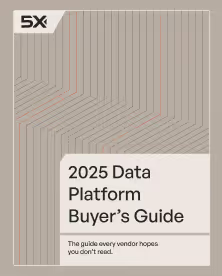
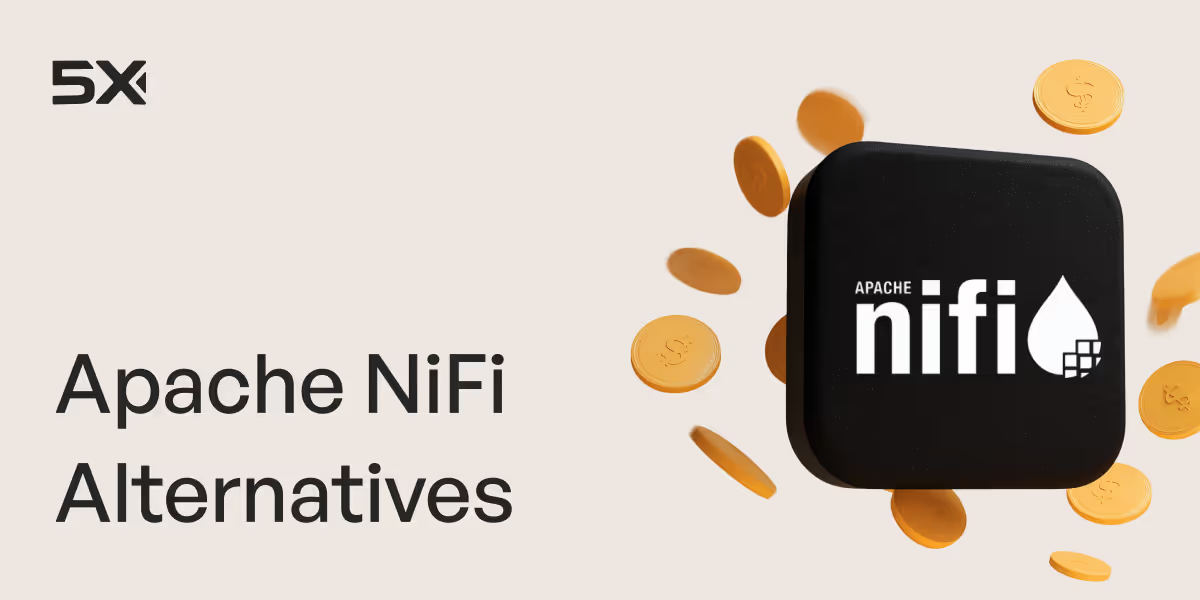
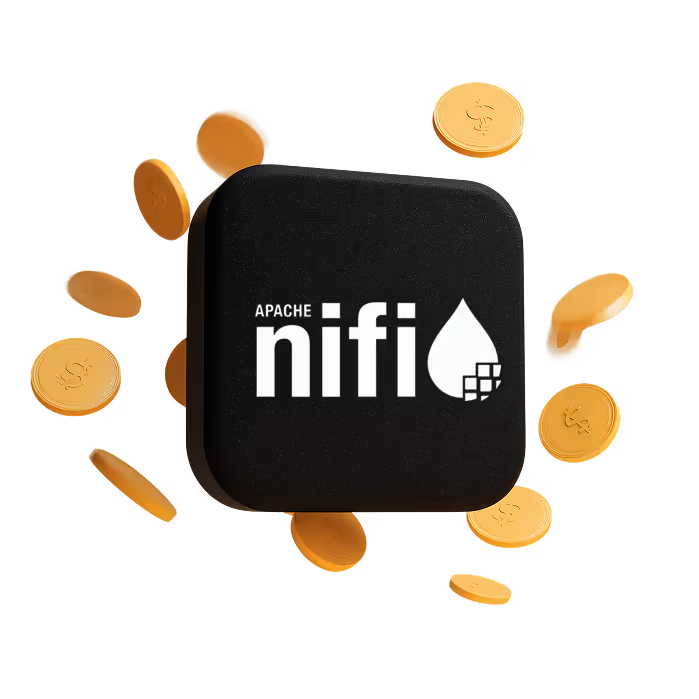
Table of Contents
TL; DR
Apache NiFi seemed like the perfect data flow solution. Visual drag-and-drop interfaces, automated routing, comprehensive data provenance—what could go wrong?
Everything, as it turns out.
You're here because NiFi's Java memory limitations are suffocating your pipelines. Because those promised "simple" visual flows have become impossible spaghetti diagrams that no one can maintain. Because cluster management has turned into a full-time nightmare that eats up your engineering resources.
The harsh reality? NiFi works brilliantly for basic data routing until the moment you need enterprise-scale reliability. That elegant visual designer becomes a performance bottleneck when you're processing millions of events. That "easy" clustering becomes a single point of failure when nodes randomly disconnect.
Here's the inside scoop on alternatives that actually scale.
Why teams are moving away from Apache NiFi
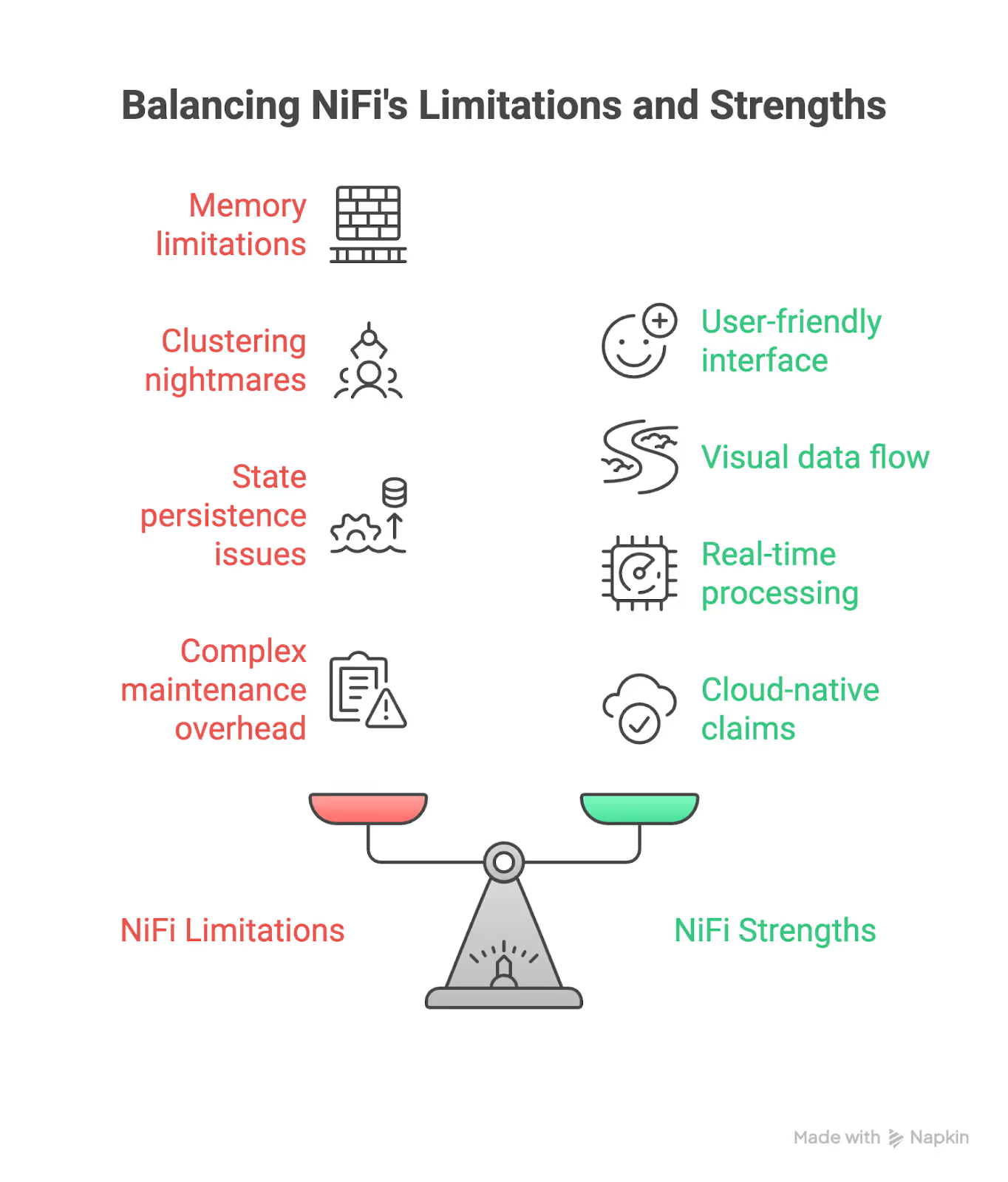
The problems are predictable. And expensive.
1. Memory limitations that kill performance
NiFi "lives within the JVM and is thus limited to the memory space it is afforded by the JVM. JVM garbage collection becomes a very important factor in restricting the total practical heap size. " When you're processing large data volumes, those memory constraints become pipeline killers. Teams report that "when there is heavy utilization of resources while running the pipeline, it gets stuck at one point; it slows down and takes a lot of time to proceed."
2. Clustering nightmares
One of NiFi's biggest limitations surfaces during cluster operations. "When a node gets disconnected from the NiFi cluster while a user is making any changes in it, then the flow.xml becomes invalid. A node cannot connect back to the cluster unless the admin manually copies flow.xml from the connected node." This manual intervention requirement makes clustering unreliable for production environments.
3. State persistence issues
"Apache NiFi has a state persistence issue in case of a primary node switch, which sometimes makes processors not able to fetch data from sourcing systems." This fundamental reliability problem can cause data loss and requires constant monitoring.
4. Limited real-time capabilities
Despite being marketed for real-time data processing, NiFi struggles with true streaming scenarios. The visual interface, while user-friendly, becomes a bottleneck for high-throughput data processing.
5. Complex maintenance overhead
While NiFi's visual interface looks appealing, "the UI interface needs to be more user-friendly," and "there are some claims that NiFi is cloud-native, but we have tested it, and it's not." The maintenance overhead grows exponentially as flows become more complex.
The real cost of staying with NiFi
Teams report spending 40-60% of their time managing NiFi infrastructure instead of building data solutions. A typical enterprise deployment requires dedicated DevOps resources just to keep clusters healthy, turning what should be a productivity tool into a resource drain.
7 Best Apache NiFi Alternatives and Competitors in 2026
1. 5X
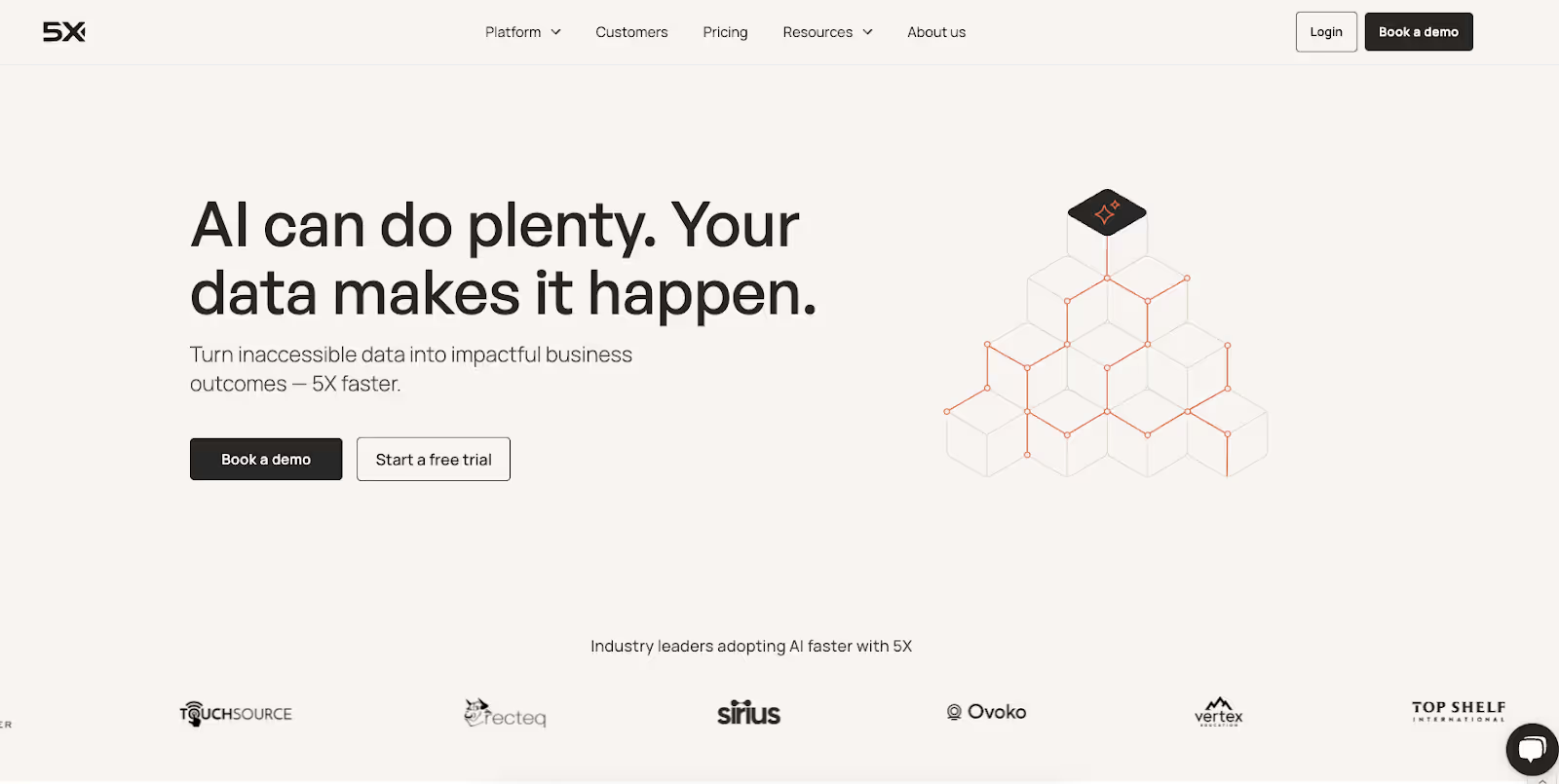
5X transforms data flow automation by providing an AI-ready platform that eliminates the infrastructure management headaches that plague Apache NiFi. Unlike NiFi's Java-based architecture with memory limitations, 5X offers a cloud-native solution designed for modern data teams who need reliable, scalable data pipelines without the operational overhead.
Features:
- 500+ pre-built connectors with custom connector development
- AI-ready data pipeline automation and orchestration
- Real-time processing capabilities without JVM limitations
- Enterprise-grade security and compliance (SOC 2, GDPR, HIPAA)
- Automated scaling and cluster management
- Built-in data quality monitoring and validation
- Visual pipeline designer with code flexibility
- Integrated monitoring and alerting
Pricing:
- Free first use case: 48-hour implementation at no cost
- Business solutions: Custom pricing based on data volume and requirements
- Enterprise deployments: Tailored pricing for your cloud environment
- Managed services: Full implementation and ongoing support available
Pros:
- No JVM memory limitations or garbage collection issues
- Eliminates clustering and state persistence problems
- AI-ready architecture for modern data applications
- Hands-on implementation team reduces time-to-value.
- Cloud-native design with automatic scaling
- No manual cluster maintenance required
- Enterprise-grade reliability and support
Cons:
- Newer platform with smaller community
- Custom pricing may not suit all budgets.
- Requires commitment to modern data architecture
- Limited public pricing information
Best for: teams tired of NiFi's operational overhead, organizations needing reliable enterprise-scale data processing, and businesses ready to modernize their data infrastructure with AI capabilities.
2. StreamSets
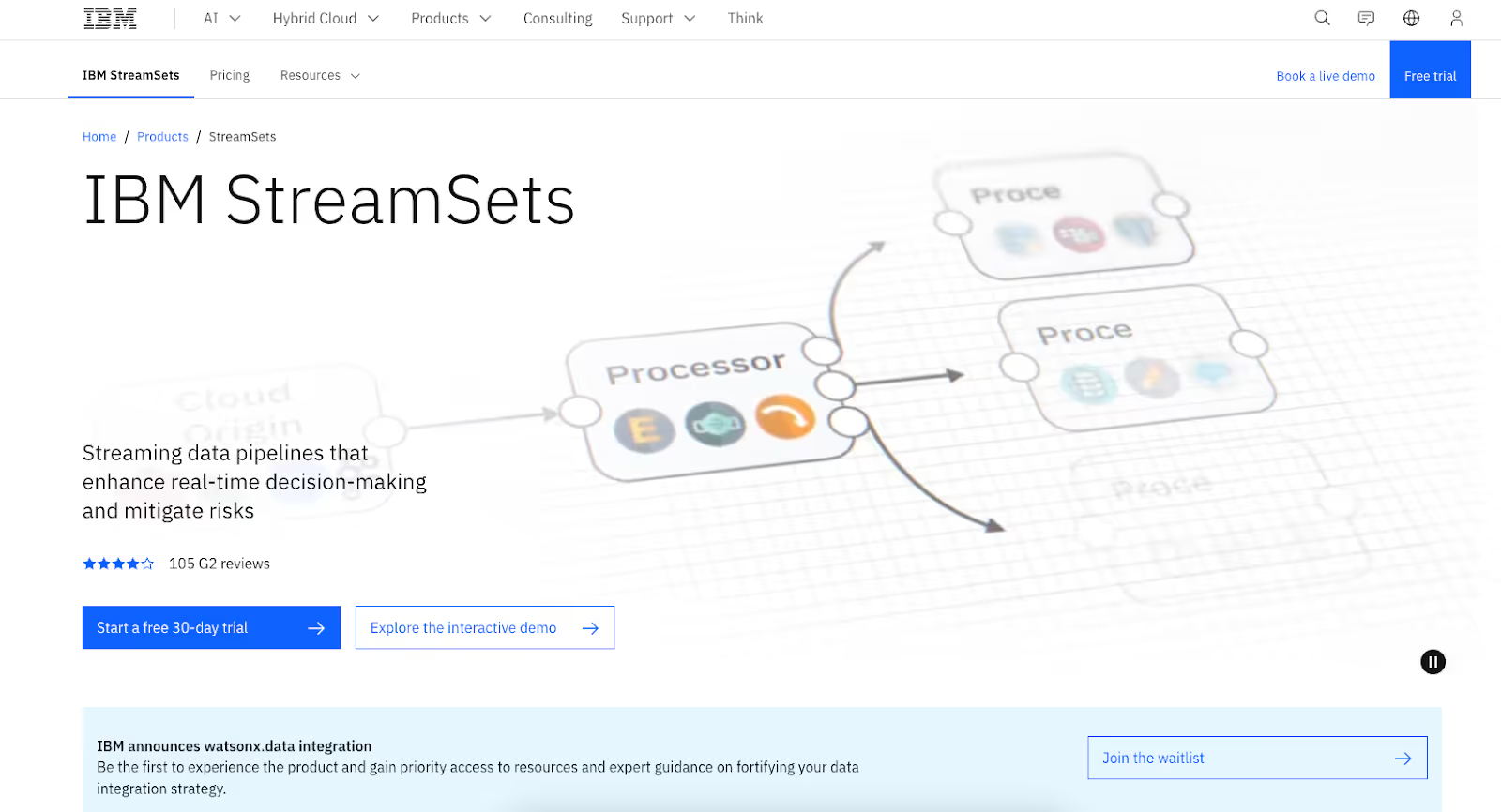
StreamSets is purpose-built for DataOps and addresses many of NiFi's enterprise limitations through its modern architecture. Unlike NiFi's monolithic design, StreamSets provides a distributed platform that handles data drift, schema evolution, and pipeline monitoring without the clustering headaches that plague NiFi deployments.
Features:
- 50+ transformation processors with drag-and-drop interface
- Advanced data drift detection and handling
- Cloud-native architecture with container support
- Real-time streaming and batch processing capabilities
- Built-in data lineage and governance features
- Edge computing support for IoT and distributed systems
- Comprehensive monitoring and alerting
Pricing:
- Free trial: 30-day evaluation period
- Subscription-based: Contact for enterprise pricing.
- Cloud and on-premise: Multiple deployment options available
Pros:
- Superior handling of schema evolution and data drift
- Modern container-based architecture
- Strong DataOps focus with built-in CI/CD
- Better performance than NiFi for large-scale deployments
- Comprehensive monitoring and observability
- No manual cluster management required
Cons:
- Limited SaaS integrations compared to modern platforms
- Pricing not publicly disclosed
- Steeper learning curve for visual designers
- Fewer community resources than NiFi
Best for: organizations implementing DataOps practices, teams needing robust schema evolution handling, and enterprises requiring reliable large-scale data processing.
3. Airbyte
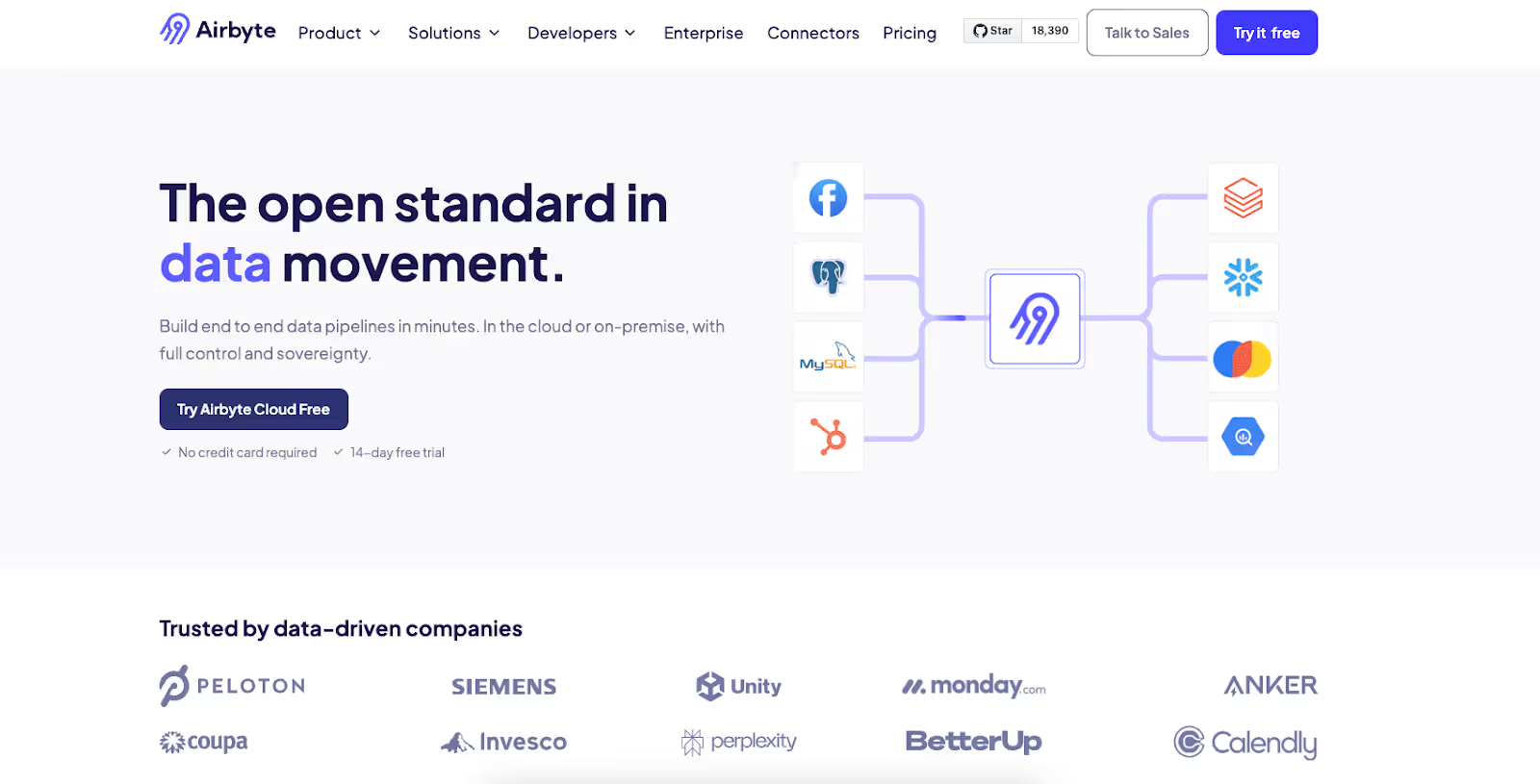
Airbyte represents the new generation of open-source data integration that learns from NiFi's limitations. With over 600 connectors and a cloud-native architecture, Airbyte eliminates the JVM constraints and clustering complexity that make NiFi difficult to scale while maintaining the flexibility that drew teams to NiFi originally.
Features:
- 600+ pre-built connectors with community contributions
- Cloud-native architecture without JVM limitations
- API-first design for programmatic management
- Real-time sync capabilities with sub-5-minute frequency
- Custom connector development through CDK
- Built-in normalization and transformation
- Kubernetes-native deployment options
Pricing:
- Open Source: Free forever (self-hosted)
- Cloud: Starting at $10/month with credits
- Teams: Capacity-based pricing model
- Enterprise: Custom pricing with advanced features
Pros:
- No JVM memory limitations or garbage collection issues
- Largest connector ecosystem with active development
- Modern API-first architecture
- Strong community and rapid development cycle
- Flexible deployment options
- Transparent pricing model
Cons:
- Requires technical expertise for optimal deployment
- Less visual than NiFi for non-technical users
- Newer platform with evolving enterprise features
- Self-hosted version requires infrastructure management.
Best for: technical teams comfortable with modern architectures, organizations needing extensive connector support, and teams wanting open-source flexibility without NiFi's limitations.
4. Talend
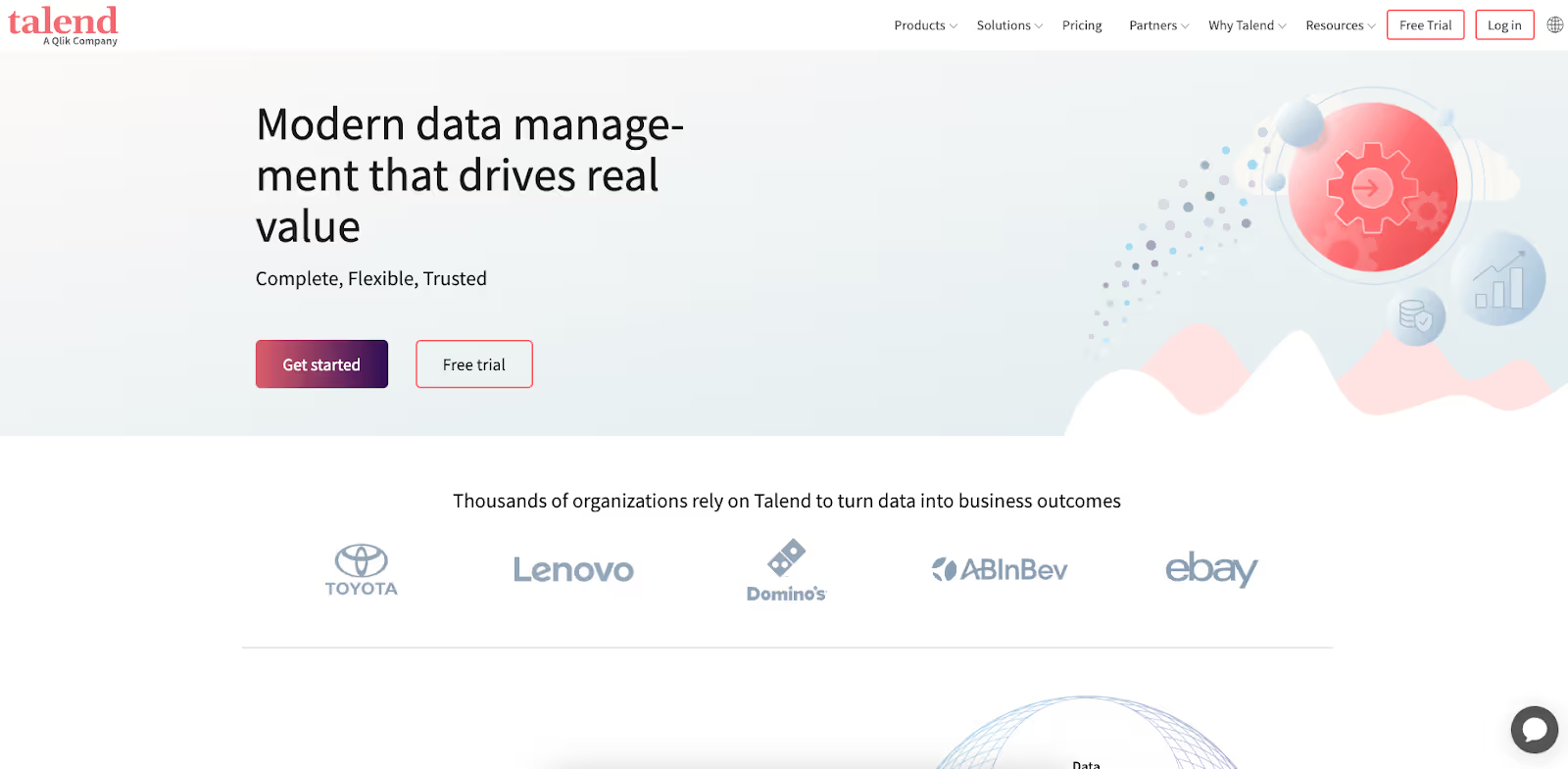
Talend offers enterprise-grade data integration that addresses NiFi's scalability and reliability issues through its mature platform. Unlike NiFi's visual-first approach that becomes unwieldy at scale, Talend provides both visual design and code generation, delivering production-ready solutions that enterprises can rely on.
Features:
- 1000+ pre-built connectors and components
- Visual design with automatic code generation
- Advanced data quality and governance tools
- Cloud and on-premise deployment options
- Machine learning integration for smart data processing
- Enterprise security and compliance features
- Comprehensive data lineage and impact analysis
Pricing:
- Community Edition: Free with basic features
- Cloud Editions: Subscription-based, starting at enterprise levels
- Enterprise: Custom pricing for full platform access
Pros:
- Mature platform with proven enterprise scalability
- Superior data quality and governance capabilities
- Strong performance for large-scale ETL operations
- Comprehensive support and documentation
- Flexible deployment options
- Advanced monitoring and management tools
Cons:
- Higher cost than open-source alternatives
- Complex licensing structure
- Steeper learning curve for advanced features
- Resource-intensive for smaller deployments
Best for: large enterprises needing comprehensive data management, organizations with complex governance requirements, and teams requiring proven scalability and support.
5. Pentaho Data Integration
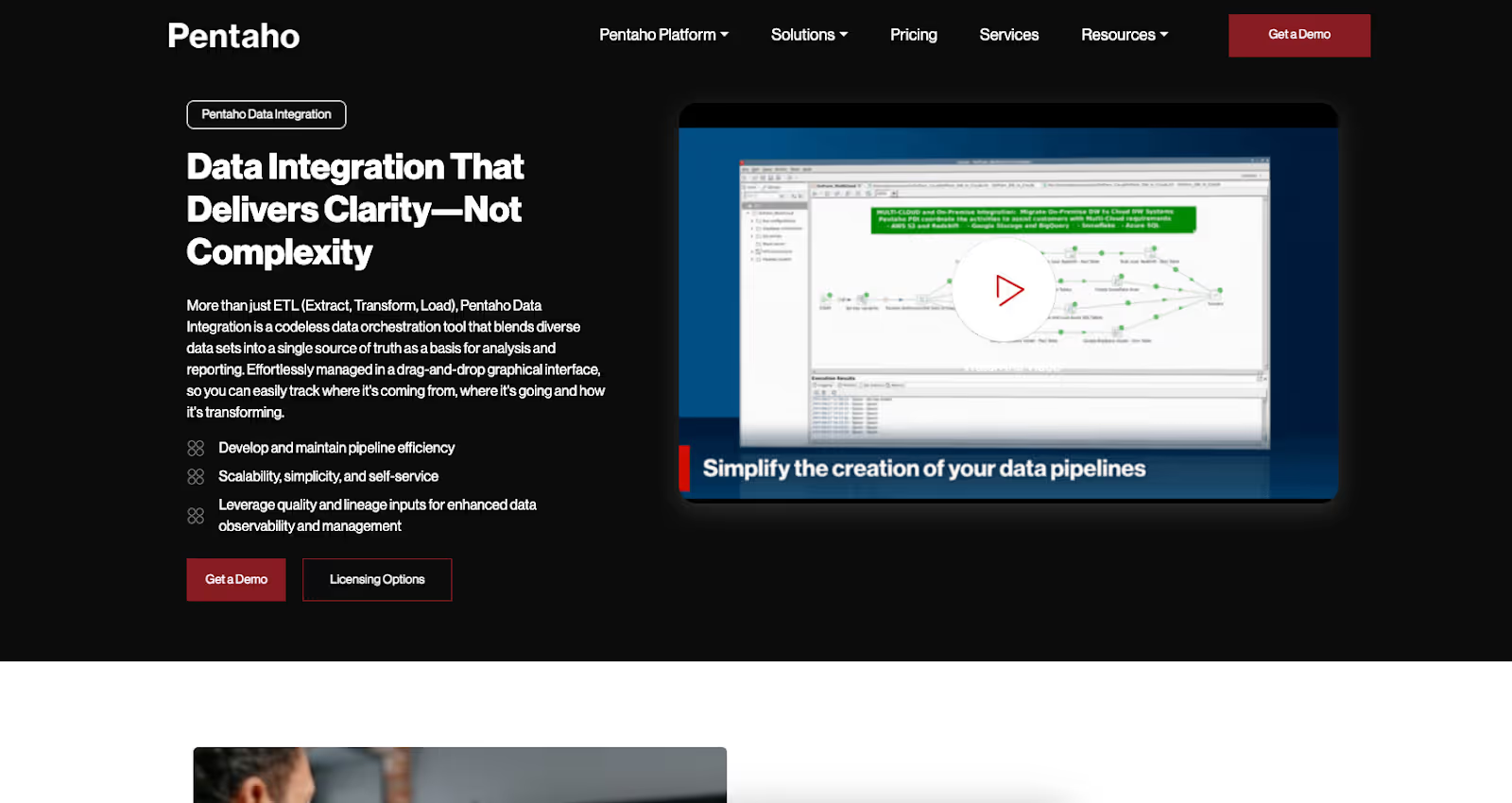
Pentaho (Kettle) provides the visual data integration experience that attracted teams to NiFi, but with better stability and enterprise features. As part of the Hitachi Vantara portfolio, Pentaho offers a mature alternative that handles the data flow automation needs without NiFi's clustering and memory management issues.
Features:
- Visual ETL designer with drag-and-drop interface
- Multi-threaded processing for improved performance
- Extensive connectivity to databases and applications
- Big data integration with Hadoop and Spark
- Repository system with version control
- Platform independence for development and deployment
- Strong community and enterprise support
Pricing:
- Community Edition: Free open-source version
- Enterprise Edition: Subscription-based with support
- Custom pricing: Available for enterprise deployments
Pros:
- User-friendly visual interface similar to NiFi
- Strong performance for traditional ETL workloads
- Mature platform with extensive documentation
- Active community and support ecosystem
- A cost-effective open-source option is available
- Better resource management than NiFi
Cons:
- Less modern than cloud-native alternatives
- Limited real-time streaming capabilities
- UI can feel dated compared to newer platforms.
- Requires technical expertise for advanced scenarios
Best for: teams familiar with visual ETL tools, organizations needing cost-effective data integration, and businesses with traditional ETL requirements.
6. Apache Kafka + Apache Camel
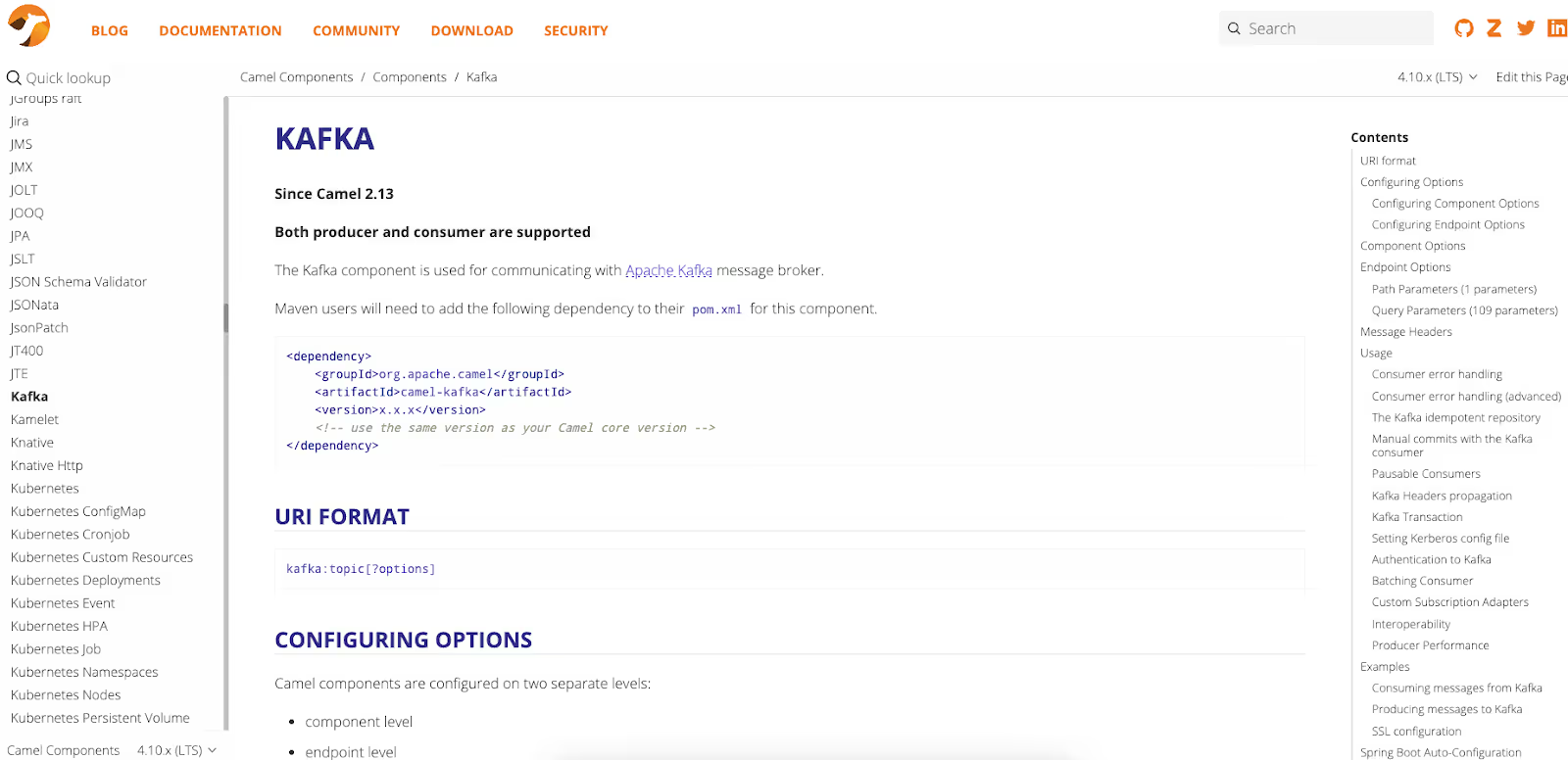
For teams that need the real-time processing capabilities that NiFi promises but can't deliver reliably, the combination of Apache Kafka and Apache Camel provides a robust, scalable alternative. This architecture separates concerns—Kafka handles high-throughput streaming while Camel manages integration patterns and routing logic.
Features:
- High-throughput, low-latency message streaming (Kafka)
- 300+ components for enterprise integration patterns (Camel)
- Fault-tolerant distributed architecture
- Horizontal scaling capabilities
- Strong ecosystem and community support
- Event-driven architecture support
- Comprehensive monitoring and metrics
Pricing:
- Open Source: Free for both Kafka and Camel
- Managed Services: Various cloud providers offer managed Kafka.
- Enterprise Support: Available through vendors like Confluent
Pros:
- Superior performance for high-throughput scenarios
- Battle-tested architecture for enterprise streaming
- Excellent horizontal scaling capabilities
- Strong ecosystem and community
- Separates concerns for better maintainability
- No single point of failure issues
Cons:
- Requires more technical expertise than visual tools
- Complex setup and configuration
- Steep learning curve for teams used to visual interfaces
- Requires understanding of streaming architectures
Best for: teams needing high-performance streaming capabilities, organizations with technical expertise, and enterprises requiring fault-tolerant real-time processing.
7. Apache Spark
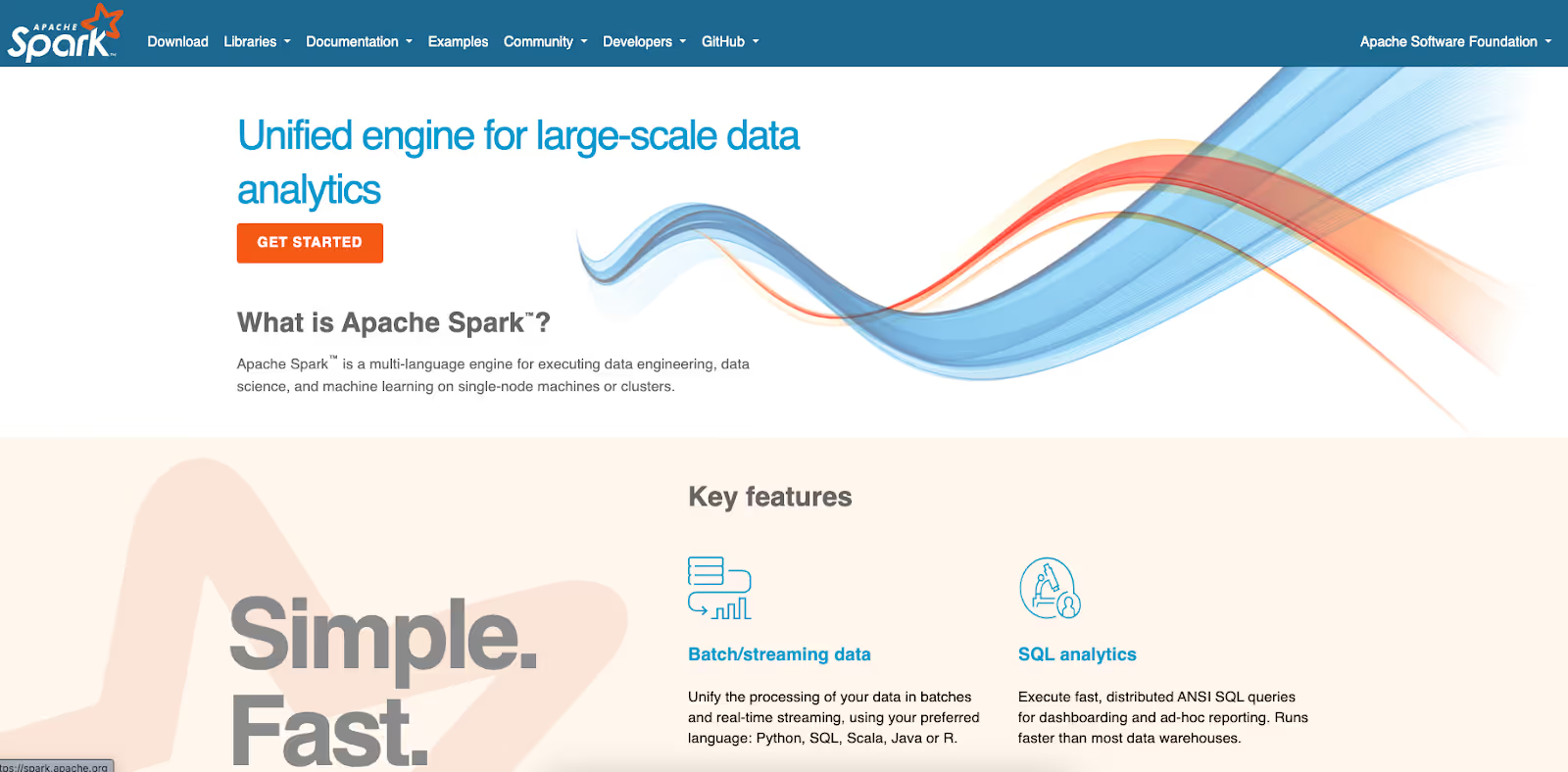
For data processing workloads that outgrow NiFi's capabilities, Apache Spark provides the computational power and scalability that enterprise data teams need. While not a direct replacement for NiFi's visual interface, Spark addresses the core limitation of reliable, large-scale data processing that causes teams to abandon NiFi.
Features:
- Unified analytics engine for large-scale data processing
- Support for batch, streaming, and machine learning workloads
- SQL, Scala, Python, R, and Java APIs
- Built-in libraries for streaming, SQL, machine learning, and graph processing
- Fault-tolerant distributed computing
- Integration with major data storage systems
- Extensive ecosystem and community support
Pricing:
- Open Source: Free Apache Spark
- Managed Services: Available on all major cloud platforms
- Enterprise Distributions: Custom pricing from vendors like Databricks
Pros:
- Exceptional performance for large-scale data processing
- Mature and battle-tested architecture
- Extensive ecosystem and community support
- Flexible APIs for different programming languages
- Superior fault tolerance and recovery
- Excellent integration with the big data ecosystem
Cons:
- Requires significant technical expertise
- No visual interface for non-technical users
- Complex cluster management for self-hosted deployments
- Steep learning curve for teams used to visual tools
Best for: technical teams with big data processing needs, organizations requiring high-performance analytics, and enterprises with dedicated data engineering resources.
Making the switch: what to consider first
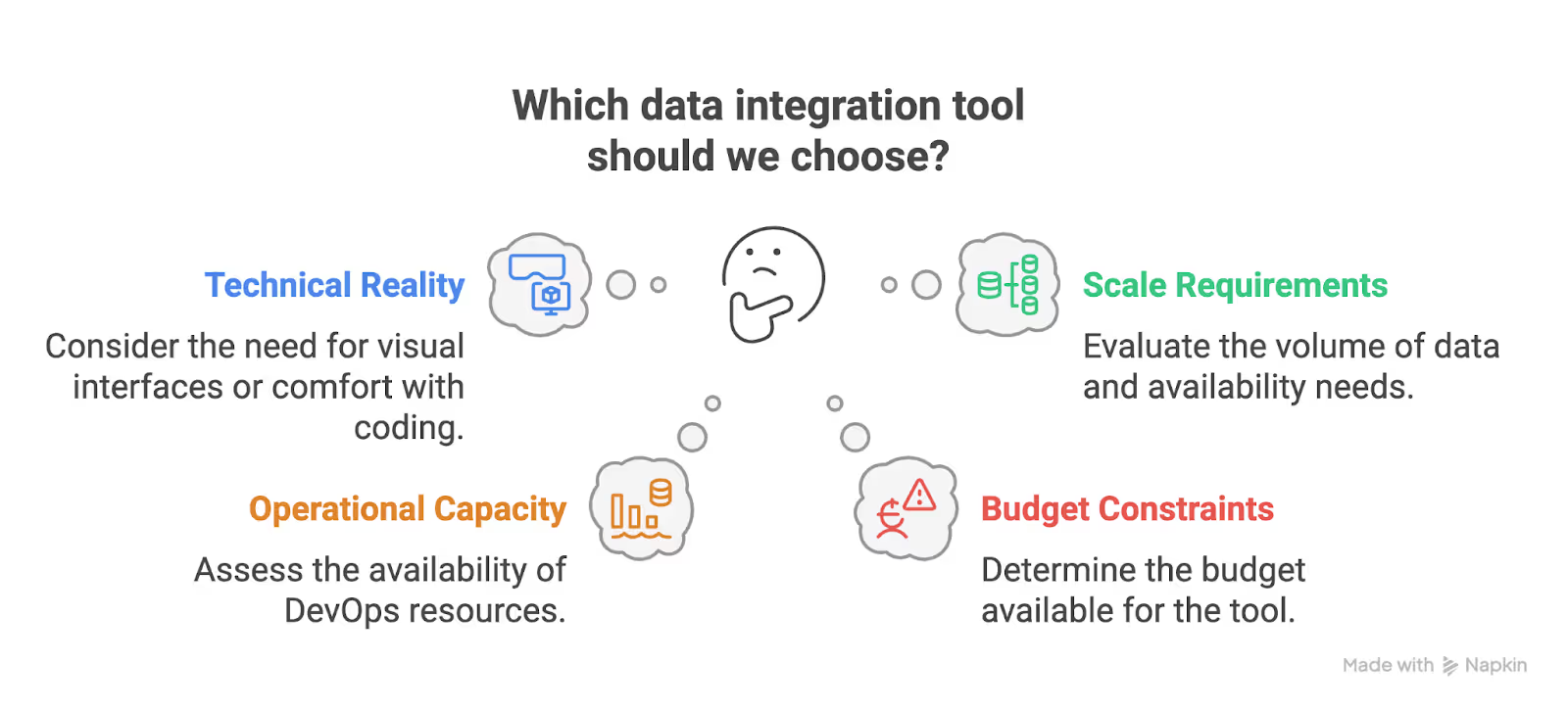
1. Your technical reality
Are you a team that needs visual interfaces for business users? Pentaho or StreamSets might be your best bet.
Do you have data engineers comfortable with code? Airbyte or the Kafka+Camel combination could unlock better performance.
2. Your scale requirements
Small to medium data volumes with basic routing? Most alternatives will work fine.
Enterprise-scale with high availability requirements? Focus on StreamSets, Talend, or the 5X platform.
3. Your operational capacity
Limited DevOps resources? Avoid solutions that require extensive cluster management.
Dedicated infrastructure team? Open-source options like Airbyte or Kafka become viable.
4. Your budget constraints
Cost-conscious organizations should evaluate Pentaho's community edition or Airbyte's open-source offering.
Enterprise budgets can consider comprehensive platforms like Talend or managed solutions like 5X.
Build reliable data flows, not maintenance headaches.
Apache NiFi pioneered visual data flow automation, but its architectural limitations have become increasingly apparent at enterprise scale. The clustering issues, memory constraints, and operational overhead that plague NiFi deployments are pushing teams toward more modern alternatives.
The good news? Today's alternatives address NiFi's core limitations while often providing better performance, reliability, and ease of management.
While each alternative solves specific aspects of NiFi's limitations, modern platforms like 5X represent the next evolution—providing the visual simplicity teams loved about NiFi while delivering the enterprise reliability and AI-ready architecture that businesses need today.
The key is choosing a solution that matches your team's technical capabilities and scale requirements, not settling for a tool that creates more problems than it solves.
Building a data platform doesn’t have to be hectic. Spending over four months and 20% dev time just to set up your data platform is ridiculous. Make 5X your data partner with faster setups, lower upfront costs, and 0% dev time. Let your data engineering team focus on actioning insights, not building infrastructure ;)
Book a free consultationHere are some next steps you can take:
- Want to see it in action? Request a free demo.
- Want more guidance on using Preset via 5X? Explore our Help Docs.
- Ready to consolidate your data pipeline? Chat with us now.
Get notified when a new article is released
Get comprehensive data capabilities, predictable pricing, and unlimited growth potential.
Get comprehensive data capabilities, predictable pricing, and unlimited growth potential.

How retail leaders unlock hidden profits and 10% margins
Retailers are sitting on untapped profit opportunities—through pricing, inventory, and procurement. Find out how to uncover these hidden gains in our free webinar.
Save your spot






%201.svg)
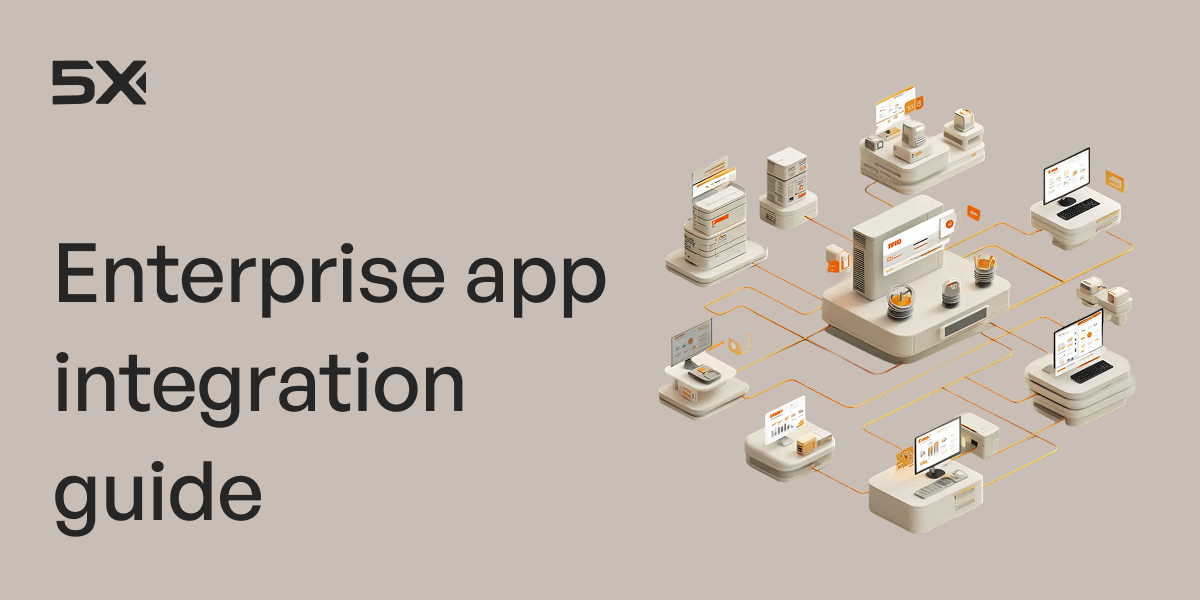
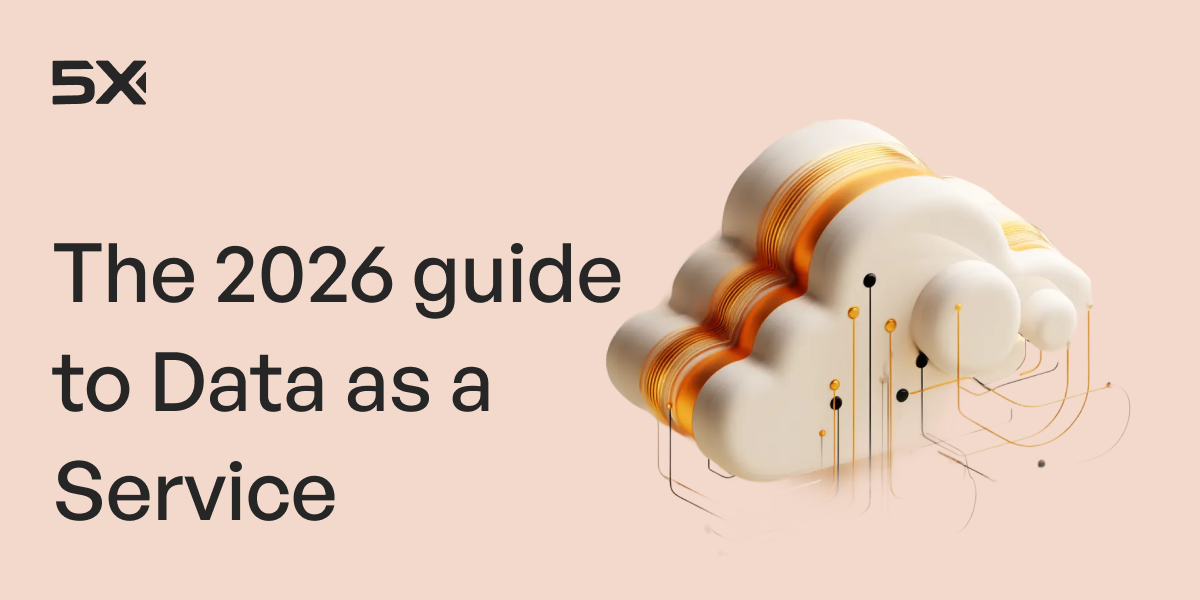
.png)






